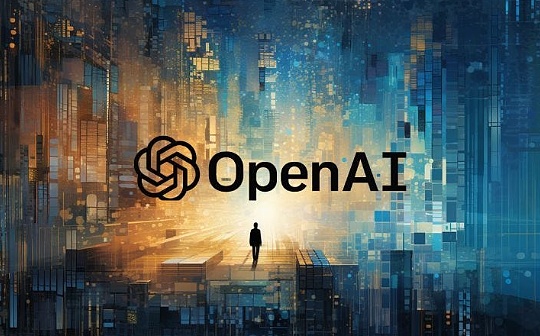LBank Research: The main force behind the surge in old coins, data analysis of the driving force behind Cardano’s rapid growth

Reprinted from panewslab
12/25/2024·4M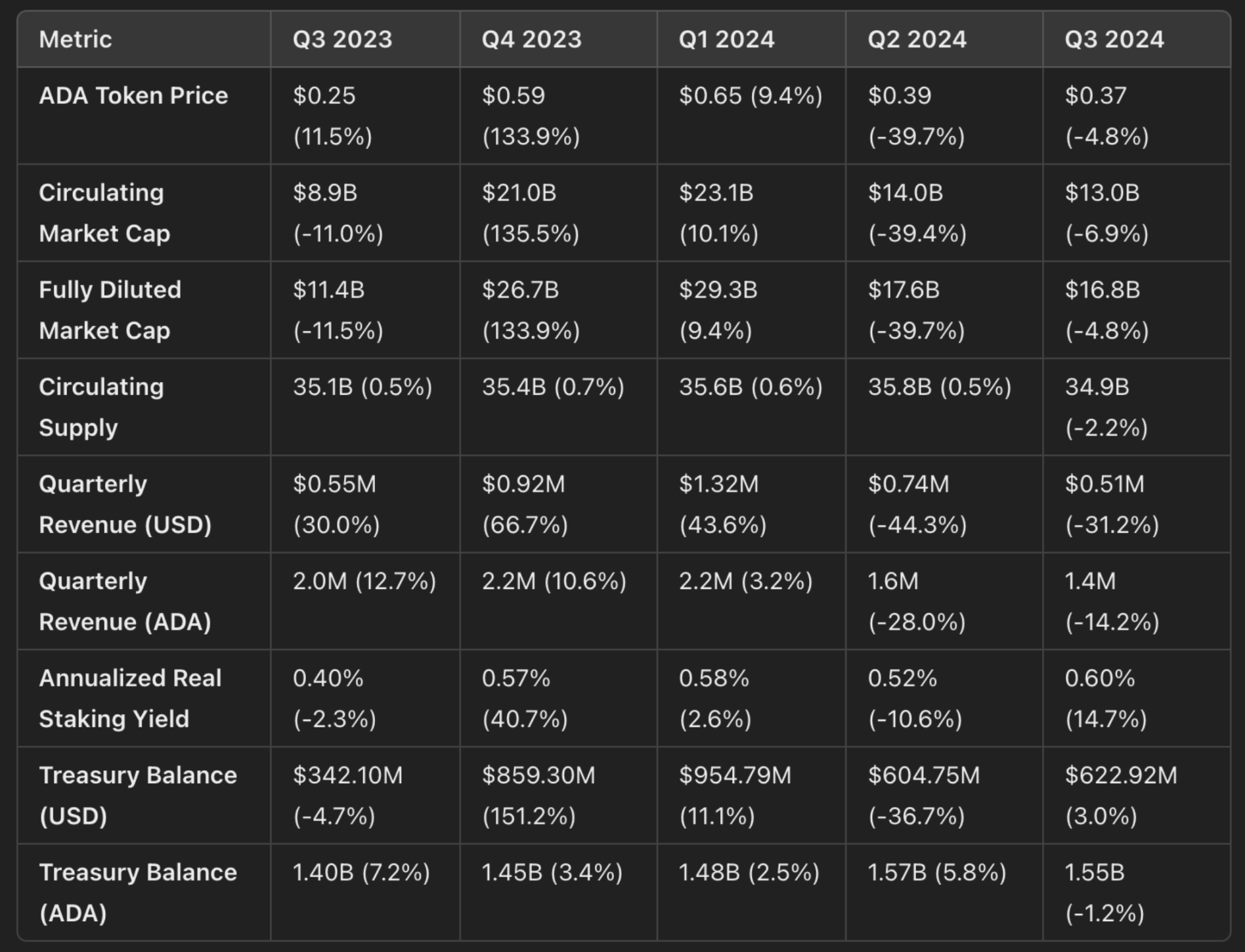
Preface
Since its launch in 2017, Cardano (ADA) has grown into a PoS network designed to push the limits of blockchain technology. As a platform dedicated to security, scalability and functionality, Cardano is more than just a cryptocurrency, but provides developers and users with a powerful environment for building decentralized applications and systems. By working closely with organizations such as Input Output Global (IOG), the Cardano Foundation, and EMURGO, Cardano has taken an important step on its roadmap to enter the competition in areas such as smart contracts, defi, and NFTs.
This article will give you an in-depth understanding of Cardano’s latest developments, key data and network features, and explore ADA’s use cases and its role in the entire crypto economy. Whether you are a developer, investor or enthusiast of blockchain technology, this article will provide you with comprehensive insights into the Cardano ecosystem, from governance innovation to financial health to the dynamic growth of DeFi, looking ahead to Cardano’s ultimate journey Goal—the future of Voltaire’s time.
Introduction to Cardano
Cardano is a PoS layer 1 network launched in 2017. Its goal is to provide security, scalability, and functionality for decentralized applications and systems built on top of its network. In addition to community support from developers, node operators, and projects, Cardano is also supported by Input Output Global (IOG), Cardano Foundation, EMURGO, and others. Together, these institutions drive the development, popularization and funding of the network, leading Cardano towards the final stage of its roadmap - the Age of Voltaire.
Cardano takes a unique approach to development compared to other smart contract networks. The Ouroboros consensus mechanism allows for stake delegation, while the extended eUTXO accounting model facilitates native token transfer, scalability, and decentralization.
With a loyal base of users and developers, Cardano has proven its staying power. After Cardano started supporting smart contracts through the 2021 Alonzo hard fork, it began to compete in more traditional crypto markets such as DeFi and NFTs.
key data
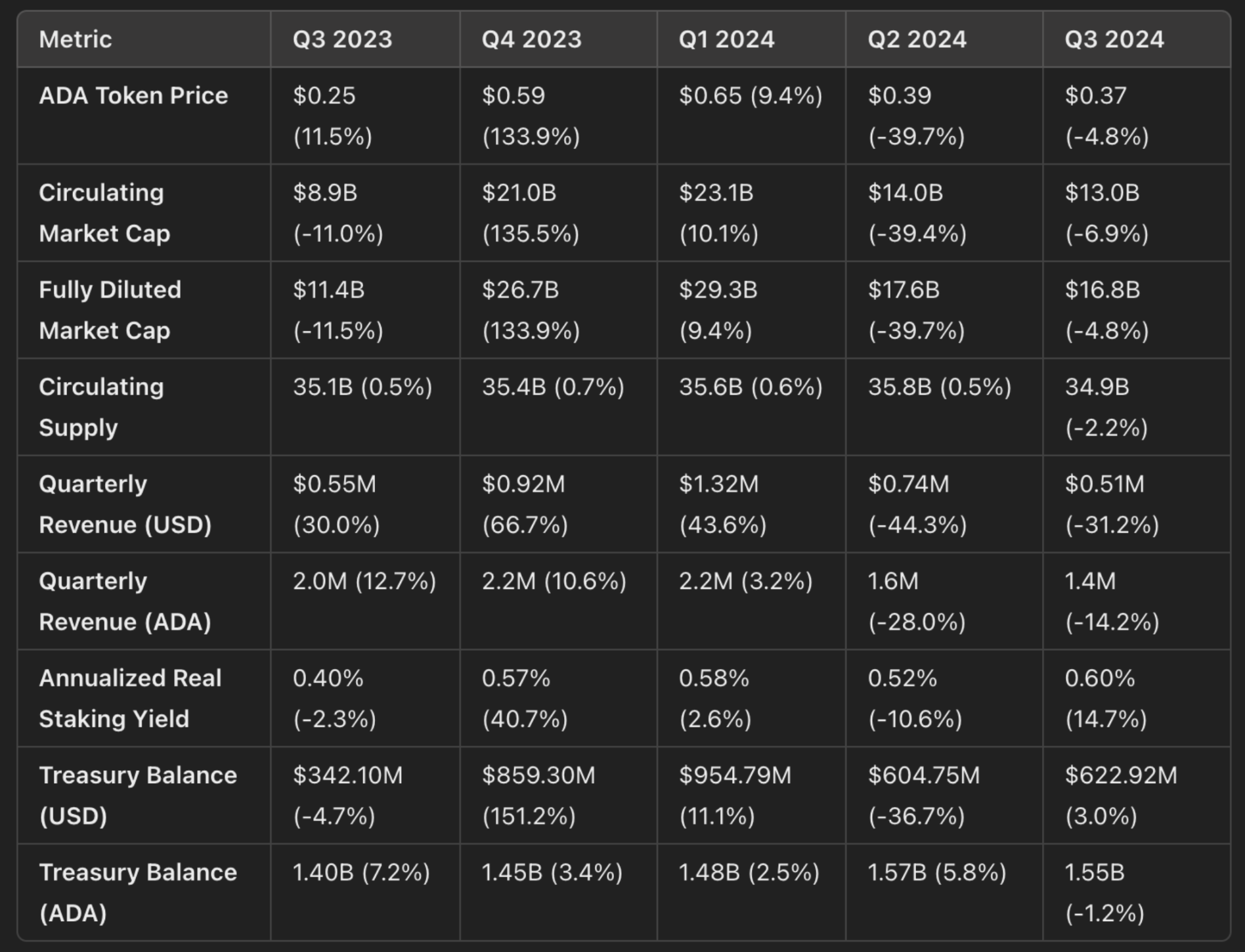
Profit data
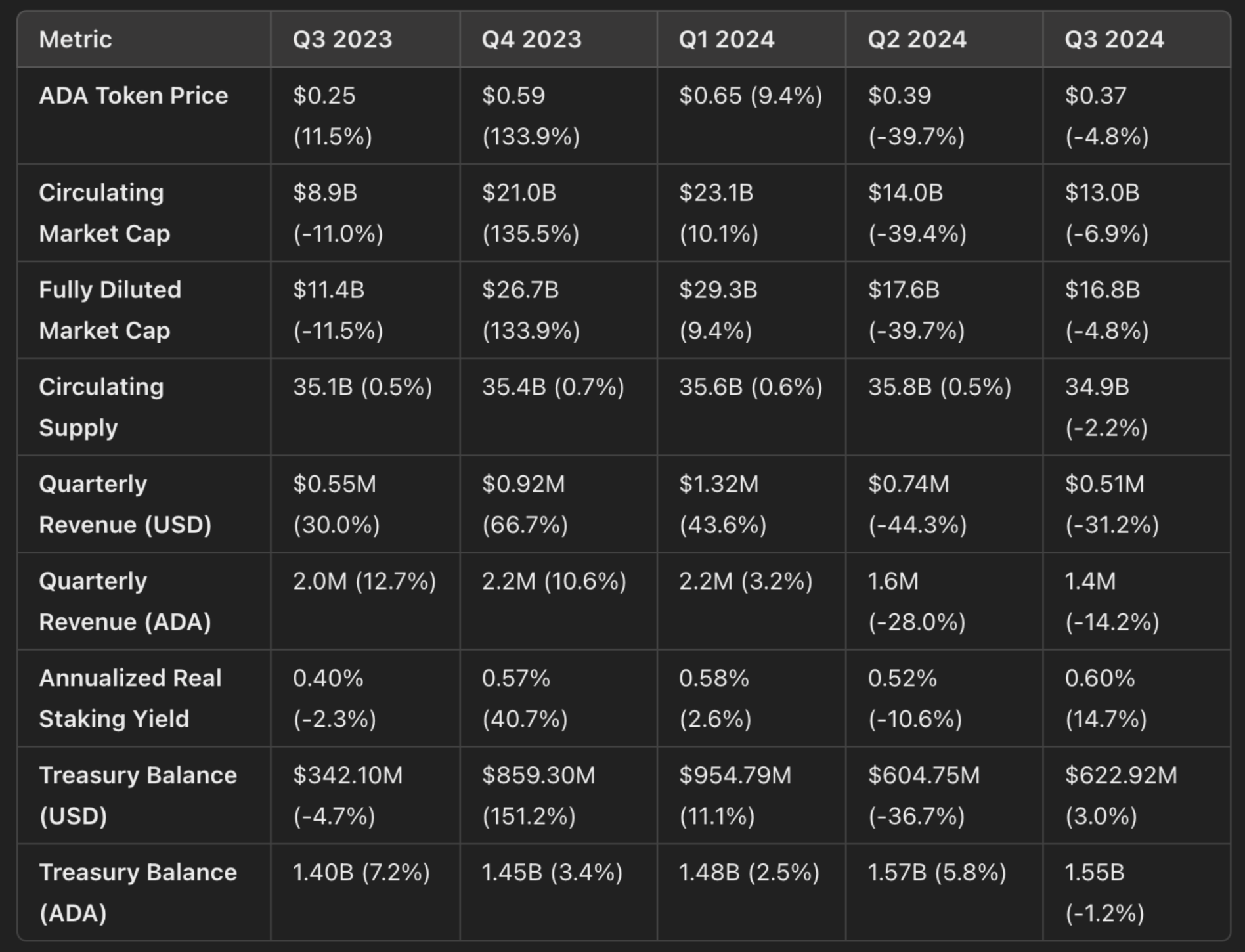
ADA is cardano’s native asset and serves as the main medium of exchange for network transactions. It has four main network-level use cases:
(i) Settling network transaction fees: ADA is used to pay for transactions on the cardano network.
(ii) Register equity pool: Users can use ADA to register an equity pool, participate in network consensus, and become a equity pool operator (SPO).
(iii) Staking: Whether as a stake pool operator or a delegator, staking ADA can help secure the network and earn token rewards.
(iv) Reward voters and fund projects: In Project Catalyst, ADA is used to reward voters and fund projects.
The maximum supply of ADA is 45 billion coins, and its circulating supply will experience inflation before reaching this maximum. After every five-day epoch, 0.3% of the ADA reserve (uncirculated ADA) will be allocated to SPO as a reward. This "inflation" approaches zero as reserves are depleted and the circulating supply approaches 45 billion.
The annualized real staking yield takes into account value dilution due to inflation. In the third quarter, the annualized effective staking yield was 0.6%, but this may vary across different equity pools.
During the third quarter, the price of ADA fell by 4.8% to $0.37. Correspondingly, the total market value of ADA fell by 6.9% month-on-month to $13 billion. The small difference in total market value was due to a 2.2% decrease in circulating supply. Due to the price drop, ADA's total market capitalization ranking in the circulation market dropped from 10th to 11th in the third quarter.
On Cardano, each transaction requires a network transaction fee, which is used to process the transaction and cover storage costs. The fee is calculated as a minimum fee plus a variable fee based on the size of the transaction. Revenue (in USD) decreased 31.2% sequentially to $0.51 million, while revenue (in ADA) decreased 14.2% sequentially to 1.4 million ADA. The difference was due to ADA's price decline throughout the quarter.
Currently, 20% of Cardano’s transaction fees go into the treasury. Cardano’s treasury balance (in ADA) fell by 1.2% month-on-month to 1.55 billion ADA, but the dollar value of the treasury increased by 3% to $622.92 million.
Daily activity data
In the third quarter, Cardano’s average daily transaction volume fell 15.9% quarter-on-quarter to 43,200, while the average number of daily active addresses (DAAs) also fell 14.5% to 27,200. Cardano’s average transaction fee remains unchanged at $0.13. However, the average transaction fee (measured in ADA) fell by 17.9% month-on-month to 0.54.
The ratio of transactions to active addresses (txs/DAAs) fell by 1.7% month-on-month to 1.59. An increase in this ratio usually means that activity is more evenly distributed among users; conversely, a decrease in the ratio indicates an increase in "heavy users."
The total pledged amount (ADA) and ADA pledge rate decreased by 0.3% and 4.1% respectively month-on-month. Due to the decline in ADA prices, total pledged volume (in USD) fell 5.1% month-on-month to $8.5 billion. The total amount staked (in USD) represents the economic security of the network.
Governance, forking
In April 2024, cardano announced the Chang hard fork, a two-phase network upgrade designed to achieve on-chain governance and complete the core goals of cardano’s final roadmap phase. Voltaire takes the final step towards cardano’s self-durability through on-chain voting and off-chain mechanisms and institutions such as member-based organization Intersect.
-
The first phase: starts after the Chang hard fork is launched on September 1, 2024. This phase opens a technical bootstrapping period, setting the stage for decentralized voting and governance actions.
-
Interim Cardano Constitution: to fill in the gaps until the real constitution is iterated through the Cardano Constitutional Workshop and ratified at the Cardano Constitutional Congress in Buenos Aires, Argentina, in December 2024 .
-
Interim Constitutional Council (ICC): consists of seven members, three of whom are elected by vote. In the first phase, the ICC has veto power over certain on-chain governance actions.
-
-
Phase Two: Will see Cardano’s on-chain governance fully online as the Cardano Constitution is completed and ratified. This phase will give ADA token holders the power to direct technical changes and treasury withdrawals, in part by introducing new user roles and delegated representation. ADA token holders will be able to delegate governance powers to DReps and SPOs, who can vote on governance proposals on their behalf.
- Register as a DRep: Open, a one-time deposit of 500 ADA is required.
Upon completion of the second phase, DReps, SPO and the Constitutional Committee will manage all areas of the network through on-chain voting and treasury systems based on CIP-1694. This will shift responsibility from IOG, Cardano Foundation and EMURGO, which historically collectively hold all seven governance (genesis) keys. Actions that can be governed include matters related to the Constitutional Committee, parameter changes, constitution updates, hard fork initiations, protocol parameter changes, and treasury withdrawals.
Intersect & SanchoNet
Testing related to CIP-1694 continues on SanchoNet, a test network launched in Q3 2023 designed to serve as a sandbox to test and build processes and tools for Cardano on-chain governance. Developers use this testnet to launch new infrastructure (such as wallets and voting browsers), SPO can test voting and proposals, and details about DReps can also be discussed here.
SanchoNet and the broader Voltaire rollout are spearheaded by Intersect, a member-based organization serving the Cardano ecosystem that combines the power of community members, SPOs and project teams. Intersect was established to bring ADA token holders together under a common vision to achieve a more transparent, collaborative and innovative cardano ecosystem.
Intersect maintains over 60 code repositories, including the complete Cardano Haskell code, and drives Cardano’s open source approach through various standing committees and working groups. In addition, Intersect is working to create an open product roadmap, annual budget process, and has been operating a grant program where projects are awarded to develop governance-related areas such as education and DRep platforms.
DeFi
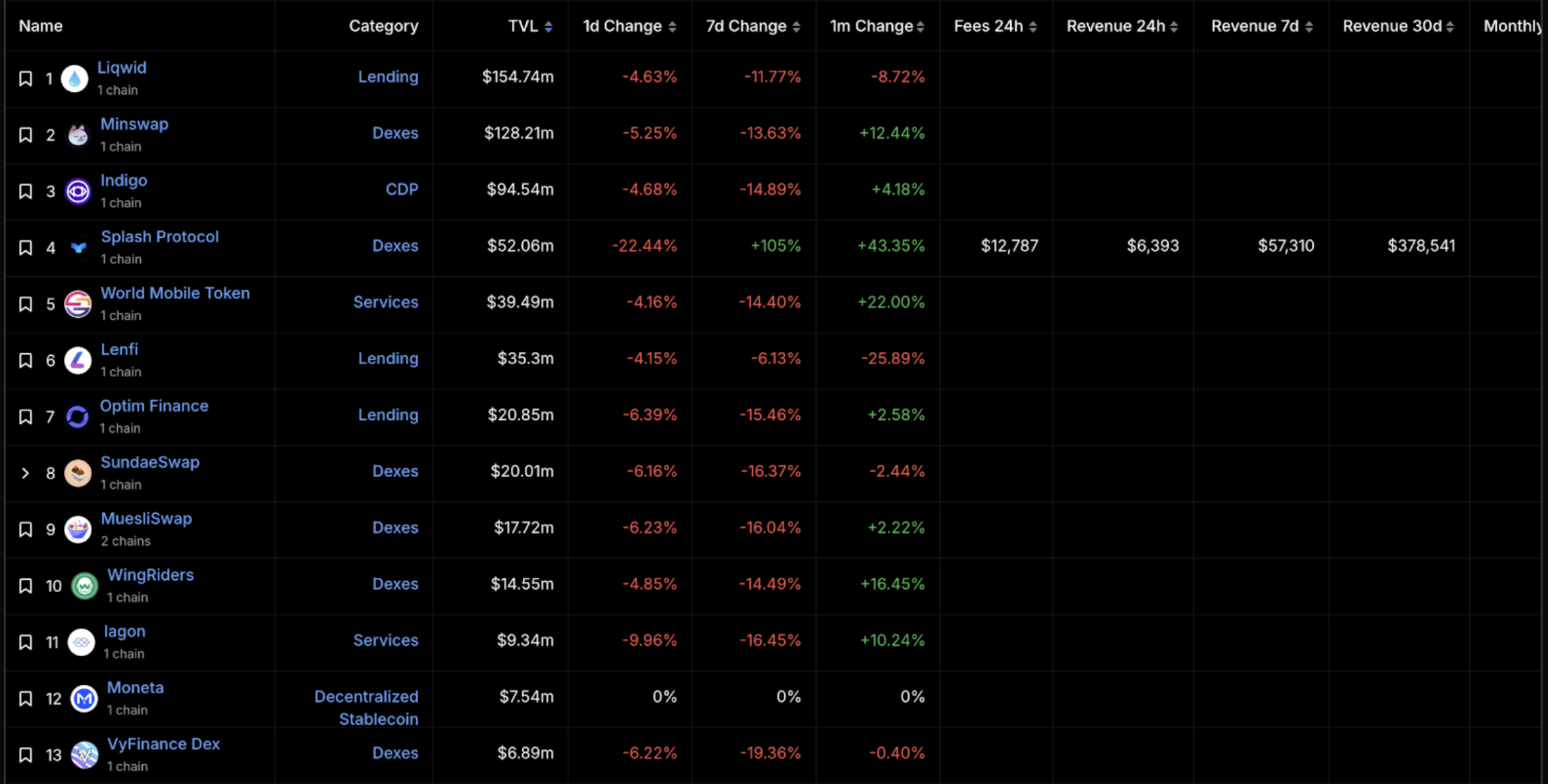
In the third quarter, cardano’s DeFi total value locked (TVL in USD) increased by 13.3% quarter-on-quarter to $231.6 million, while its DeFi diversity score increased by 12.5% to 9. There were also many changes in the TVL of various protocols in the third quarter.
-
Minswap’s TVL increased slightly by 4.4% month-on-month to $58.6 million.
-
Liqwid's TVL increased sharply by 77.2% to $47.1 million, surpassing Indigo, which saw its TVL decline by 19.7% sequentially to $38.4 million.
-
Smaller protocols such as Splash Protocol and SundaeSwap grew by 76% and 26% to $16.9 million and $16 million respectively.
Indigo is a synthetic asset issuer offering iUSD, iBTC and iETH. One week after the end of the third quarter, Indigo completed the upgrade to V2.1. This upgrade introduces algorithmic interest rates, splitting the interest between the treasury and INDY stakers, and a number of other improvements.
Splash is a decentralized exchange (DEX) that launched in July after raising 17.2 million ADA through the SPLASH token sale in May. Splash is also working on snek.fun, a protocol similar to pump.fun on Solana that allows users to easily launch and trade tokens. Launched in September, the app saw over 2,230 tokens created and 4.5 million (ADA) traded on its first day.
SundaeSwap continued its Q2 momentum with the launch of the V3 upgrade, which introduced a dynamic fee model and increased transaction load capacity. The launch included a 90-day reduction in transaction fees, which expired in August, and a proposal to increase fees was passed in September. SundaeSwap’s revenue is distributed to SUNDAE token holders, SundaeSwap’s treasury, Sundae Labs, etc.
Ada Token Unlocked
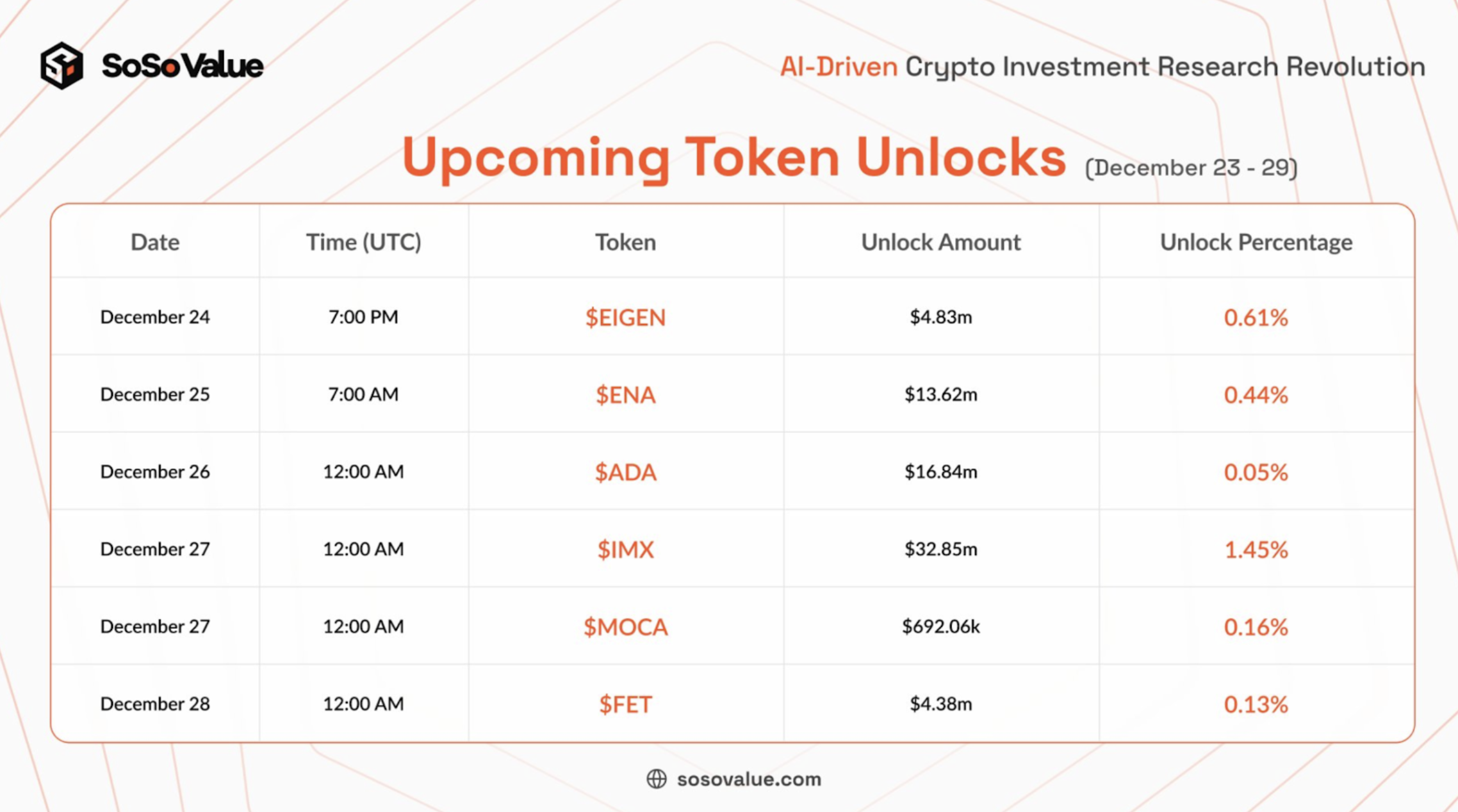
Recently, Cardano (ADA) will undergo a token unlock this week. Approximately 16.84 million ADA tokens are expected to be unlocked, accounting for 0.05% of the existing circulating supply.
future outlook
Cardano launched in 2017 as a PoS layer 1 network that aims to provide a secure, scalable and feature-rich platform to support decentralized applications and systems. Through its unique Ouroboros consensus mechanism and extended eUTXO model, Cardano has demonstrated competitiveness in the fields of smart contracts, DeFi and NFT.
With the implementation of the Alonzo hard fork in 2021, Cardano has entered a new stage of development after supporting smart contracts. In the future, Cardano will achieve complete on-chain governance and self-durability through the Chang hard fork, ushering in the Voltaire era. By introducing new governance mechanisms, increasing the diversity of the DeFi ecosystem and TVL growth, Cardano is expected to continue to consolidate its position in the blockchain industry and promote the further development of its ecosystem through continued technological innovation and community governance.

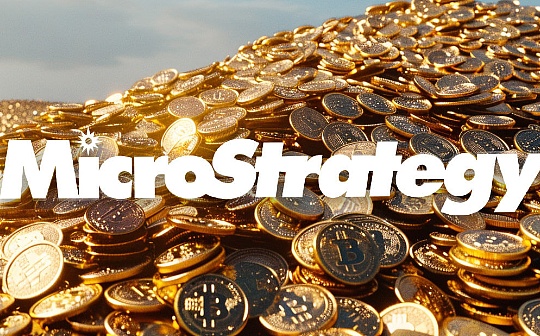
 jinse
jinse
 chaincatcher
chaincatcher
